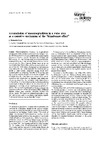Identificador persistente para citar o vincular este elemento:
https://accedacris.ulpgc.es/jspui/handle/10553/1184
| Campo DC | Valor | idioma |
|---|---|---|
| dc.contributor.author | Hernández-León, Santiago | en_US |
| dc.contributor.other | Facultad de Ciencias del Mar | - |
| dc.contributor.other | Departamento de Biología | - |
| dc.date.accessioned | 2009-10-08T02:31:00Z | - |
| dc.date.accessioned | 2018-03-01T13:48:42Z | - |
| dc.date.available | 2018-03-01T13:48:42Z | - |
| dc.date.issued | 1991 | en_US |
| dc.identifier.isbn | 253162 | - |
| dc.identifier.issn | 0025-3162 | en_US |
| dc.identifier.other | 868 | - |
| dc.identifier.uri | https://accedacris.ulpgc.es/handle/10553/1184 | - |
| dc.description.abstract | Mesozooplankton biomass (as displacement volume and protein content) and electron-transport system (ETS) activity have been studied in the coastal waters around the Canary Islands. Increases in biomass and ETS activity, on a unit volume basis, were observed in the wakes of the islands. The biomass values obtained in the leeward area for Gran Canaria Island were up to ten times higher than those observed for typical oceanic waters around this archipelago. Sampling was performed in May 1986 at the end of the characteristic vertical mixing period in these waters. Relatively strong winds were recorded prior to sampling. Specific ETS activity was higher at the windward stations on the island shelf. This correlates with the observation in a recent study of increased primary production on the shelf area, where turbulence produced by the northerly trade winds has a marked effect. The persistence of this turbulence during a prolonged wind-pulse results in an accumulation of organisms in the wake of the islands due to current dynamics. This process is proposed as being an important causative mechanism of the island-mass effect. Different biomass values were recorded between circular and oblong islands. The latter are oriented towards the current and the northerly trade winds, and display significantly lower biomass values than the former. | en_US |
| dc.language | eng | en_US |
| dc.publisher | 0025-3162 | - |
| dc.relation.ispartof | Marine Biology | en_US |
| dc.source | Marine Biology [ISSN 0025-3162], v. 109, p. 141-147 | en_US |
| dc.subject | 251001 Oceanografía biológica | en_US |
| dc.subject.other | Zooplankton | en_US |
| dc.subject.other | Canary Islands | en_US |
| dc.title | Accumulation of mesozooplankton in a wake area as a causative mechanism of the island- mass effect | en_US |
| dc.type | info:eu-repo/semantics/Article | en_US |
| dc.type | Article | en_US |
| dc.identifier.doi | 10.1007/BF01320241 | |
| dc.identifier.scopus | 0000812249 | - |
| dc.contributor.authorscopusid | 6701465678 | |
| dc.contributor.authorscopusid | 6701465678 | - |
| dc.contributor.authorscopusid | Oceanografía biológica | - |
| dc.contributor.authorscopusid | Biología | - |
| dc.contributor.authorscopusid | Facultad de Ciencias del Mar | - |
| dc.contributor.authorscopusid | Centro de Centro de Biotecnología Marina | - |
| dc.contributor.authorscopusid | Oceanografía biológica | - |
| dc.contributor.authorscopusid | Biología | - |
| dc.contributor.authorscopusid | Facultad de Ciencias del Mar | - |
| dc.contributor.authorscopusid | Centro de Centro de Biotecnología Marina | - |
| dc.contributor.authorscopusid | Oceanografía biológica | - |
| dc.contributor.authorscopusid | Biología | - |
| dc.contributor.authorscopusid | Facultad de Ciencias del Mar | - |
| dc.contributor.authorscopusid | Centro de Centro de Biotecnología Marina | - |
| dc.contributor.authorscopusid | Oceanografía biológica | - |
| dc.contributor.authorscopusid | Biología | - |
| dc.contributor.authorscopusid | Facultad de Ciencias del Mar | - |
| dc.contributor.authorscopusid | Centro de Centro de Biotecnología Marina | - |
| dc.contributor.authorscopusid | Oceanografía biológica | - |
| dc.contributor.authorscopusid | Biología | - |
| dc.contributor.authorscopusid | Facultad de Ciencias del Mar | - |
| dc.contributor.authorscopusid | Centro de Centro de Biotecnología Marina | - |
| dc.contributor.authorscopusid | Oceanografía biológica | - |
| dc.contributor.authorscopusid | Biología | - |
| dc.contributor.authorscopusid | Facultad de Ciencias del Mar | - |
| dc.contributor.contentdm | Centro de Centro de Biotecnología Marina | - |
| dc.contributor.contentdm | Oceanografía biológica | - |
| dc.contributor.contentdm | Biología | - |
| dc.contributor.contentdm | Facultad de Ciencias del Mar | - |
| dc.identifier.absysnet | 225860 | - |
| dc.identifier.crisid | 1255 | - |
| dc.description.lastpage | 147 | - |
| dc.description.firstpage | 141 | - |
| dc.relation.volume | 109 | - |
| dc.investigacion | Ciencias | en_US |
| dc.rights.accessrights | info:eu-repo/semantics/openAccess | - |
| dc.type2 | Artículo | en_US |
| dc.identifier.external | 1255 | - |
| dc.identifier.external | 1255 | - |
| dc.identifier.external | 1255 | - |
| dc.identifier.external | 1255 | - |
| dc.identifier.external | 1255 | - |
| dc.utils.revision | Sí | en_US |
| dc.date.coverdate | Febrero 1991 | |
| dc.identifier.ulpgc | Sí | es |
| dc.description.scie | SCIE | |
| item.grantfulltext | open | - |
| item.fulltext | Con texto completo | - |
| crisitem.author.dept | GIR IOCAG: Oceanografía Biológica y Cambio Global | - |
| crisitem.author.dept | IU de Oceanografía y Cambio Global | - |
| crisitem.author.dept | Departamento de Biología | - |
| crisitem.author.orcid | 0000-0002-3085-4969 | - |
| crisitem.author.parentorg | IU de Oceanografía y Cambio Global | - |
| crisitem.author.fullName | Hernández León, Santiago Manuel | - |
| Colección: | Artículos | |
Citas SCOPUSTM
61
actualizado el 08-jun-2025
Citas de WEB OF SCIENCETM
Citations
63
actualizado el 08-jun-2025
Visitas
178
actualizado el 22-feb-2025
Descargas
313
actualizado el 22-feb-2025
Google ScholarTM
Verifica
Altmetric
Comparte
Exporta metadatos
Los elementos en ULPGC accedaCRIS están protegidos por derechos de autor con todos los derechos reservados, a menos que se indique lo contrario.
